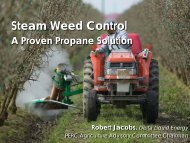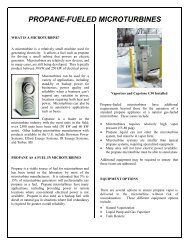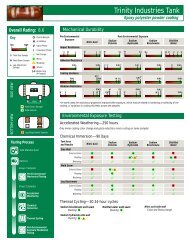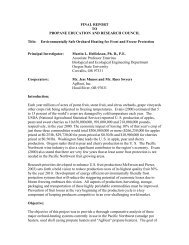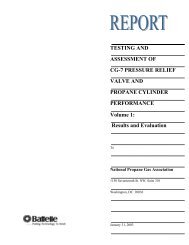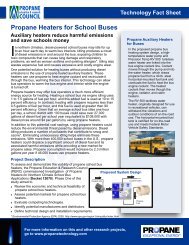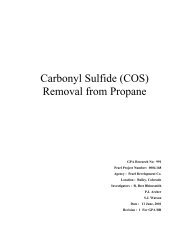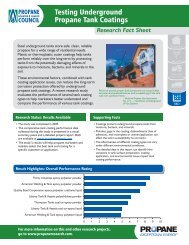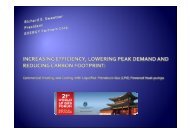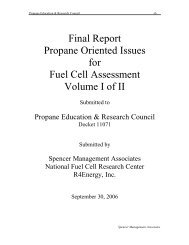Code Approval of Composite Propane Cylinders for Indoor Use ...
Code Approval of Composite Propane Cylinders for Indoor Use ...
Code Approval of Composite Propane Cylinders for Indoor Use ...
You also want an ePaper? Increase the reach of your titles
YUMPU automatically turns print PDFs into web optimized ePapers that Google loves.
Task 6 – Per<strong>for</strong>m Detailed Fire Testing <strong>of</strong> the <strong>Composite</strong> <strong>Propane</strong><strong>Cylinders</strong>Underwriters Laboratories Inc. was requested by Battelle to investigate the fire per<strong>for</strong>mance <strong>of</strong>composite propane gas cylinders <strong>for</strong> use with portable heating appliances. The heating applianceequipped with the composite propane gas cylinder is intended <strong>for</strong> indoor use as a portable spaceheater and as such it is important to understand the fire characteristics within a building. The firetesting was conducted at the Underwriters Laboratories fire testing facility in Northbrook,Illinois on August 10, 11, 12, 18, and 19, 2005 and October 18 and 19, 2005.The project addressed the following fire safety concerns: (i) fire hazard from an empty storedcylinder; (ii) contribution <strong>of</strong> the leaking gas from a composite cylinder to fire hazards in a roomfire; (iii) explosion or violent rupture <strong>of</strong> the composite cylinder when exposed to ignition source;(iv) high velocity jetting <strong>of</strong> the propane gas flames upon leakage from the cylinder; (v)contribution to room fires from a spare composite cylinder stored next to heating appliance; and(vi) effects <strong>of</strong> fire hose spray on a burning composite cylinder.To meet the project objectives and the fire safety concerns, the following Test Types wereidentified:• Test Type 1 – Heat and smoke release rate from empty cylinder• Test Type 2 – Fire per<strong>for</strong>mance <strong>of</strong> the heating appliance with composite gas cylinder in aroom with the cylinder as the item ignited• Test Type 3 – Fire per<strong>for</strong>mance <strong>of</strong> the heating appliance with composite cylinder in aroom fire growing to flashover conditions.• Test Type 4 – Assess fire per<strong>for</strong>mance <strong>of</strong> cylinder subjected to a steady 300 kW roomfire.• Test Type 5 – Assess the per<strong>for</strong>mance <strong>of</strong> a burning pressurized composite cylinder afterimpacted by a water hose stream.The tests were conducted on two designs <strong>of</strong> composite cylinders: a one-piece designincorporating a non-pressure-load-bearing liner, and a two-piece, unlined design. These arereferred to as Design 1 and Design 2, respectively.Test Type 1 TestsThe tests making up Test Type 1 were conducted on the two designs <strong>of</strong> empty cylinderspositioned vertically and exposed to a standard test igniter. The heat and smoke release ratesfrom the burning cylinders were measured. Visual observations <strong>of</strong> the burning, including anymelting and dripping, were also recorded. As the jackets and the resins used in the compositecylinders are combustible, these data can be used by fire protection engineers in consideringstorage requirements <strong>of</strong> empty cylinders.The test results are summarized in Table 8.<strong>Composite</strong> <strong>Propane</strong> <strong>Cylinders</strong> 37February 2007<strong>for</strong> <strong>Indoor</strong> <strong>Use</strong> — Phase IIBattelle



